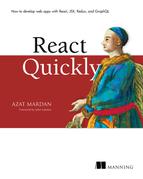About the Author

I’ve published more than 14 books and 17 online courses (https://node.university), most of them on the cloud, React, JavaScript, and Node.js. (One book is about how to write books, and another is about what to do after you’ve written a few books.) Before focusing on Node, I programmed in other languages (Java, C, Perl, PHP, Ruby), pretty much ever since high school (more than a dozen years ago) and definitely more than the 10,000 hours prescribed.[1]
Right now, I’m a Technology Fellow at one of the top 10 U.S. banks, which is also a Fortune 500 company: Capital One Financial Corporation, in beautiful San Francisco. Before that, I worked for small startups, giant corporations, and even the U.S. federal government, writing desktop, web, and mobile apps; teaching; and doing developer evangelism and project management.
I don’t want to take too much of your time telling you about myself; you can read more on my blog (http://webapplog.com/about) and social media (www.linkedin.com/in/azatm). Instead, I want to write about my experience that’s relevant to this book.
When I moved to the sunny state of California in 2011 to join a startup and go through a business accelerator (if you’re curious, it was 500 Startups), I started to use modern JavaScript. I learned Backbone.js to build a few apps for the startup, and I was impressed. The framework was a huge improvement in code organization over other SPAs I’d built in prior years. It had routes and models. Yay!
I had another chance to see the astounding power of Backbone and isomorphic JavaScript during my work as software engineering team lead at DocuSign, the Google of e-signatures (it has a 70% market share). We reengineered a seven-year-old monolithic ASP.NET web app that took four weeks for each minor release into a snappy Backbone-Node-CoffeeScript-Express app that had great user experience and took only one or two weeks for its release. The design team did great work with usability. Needless to say, there were boatloads of UI views with various degrees of interactivity.
The end app was isomorphic before such a term even existed. We used Backbone models on the server to prefetch the data from APIs and cache it. We used the same Jade templates on the browser and the server.
It was a fun project that made me even more convinced of the power of having one language across the entire stack. Developers versed in C# and front-end JavaScript (mostly jQuery) from the old app would spend a sprint (one release cycle, typically a week or two) and fall in love with the clear structure of CoffeeScript, the organization of Backbone, and the speed of Node (both the development and the running speed).
My decade in web development exposed me to the good, the bad, and the ugly (mostly ugly) of front-end development. This turned out to be a blessing in disguise, because I came to appreciate React even more, once I switched to it.
If you’d like to receive updates, news, and tips, then connect with me online by following, subscribing, friending, stalking, whatever:
- Twitter—https://twitter.com/azat_co
- Website—http://azat.co
- LinkedIn—http://linkedin.com/in/azatm
- Professional blog—http://webapplog.com
- Publications—http://webapplog.com/books
For in-person workshops and courses, visit http://NodeProgram.com or https://Node.University, or send me a message via https://webapplog.com/azat.
